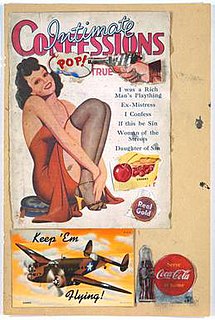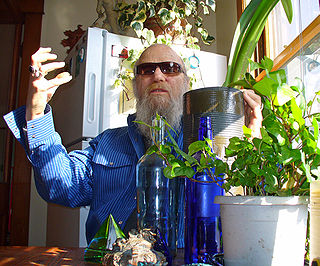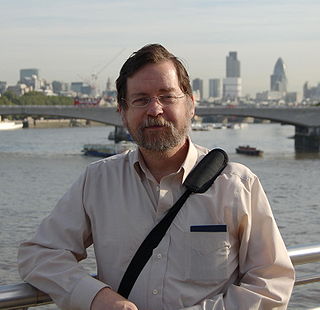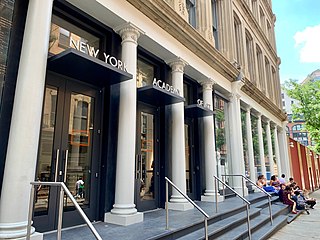Related Research Articles

Andy Warhol was an American visual artist, film director, and producer who was a leading figure in the visual art movement known as pop art. His works explore the relationship between artistic expression, advertising, and celebrity culture that flourished by the 1960s, and span a variety of media, including painting, silkscreening, photography, film, and sculpture. Some of his best-known works include the silkscreen paintings Campbell's Soup Cans (1962) and Marilyn Diptych (1962), the experimental films Empire (1964) and Chelsea Girls (1966), and the multimedia events known as the Exploding Plastic Inevitable (1966–67).

Pop art is an art movement that emerged in the United Kingdom and the United States during the mid- to late-1950s. The movement presented a challenge to traditions of fine art by including imagery from popular and mass culture, such as advertising, comic books and mundane mass-produced objects. One of its aims is to use images of popular culture in art, emphasizing the banal or kitschy elements of any culture, most often through the use of irony. It is also associated with the artists' use of mechanical means of reproduction or rendering techniques. In pop art, material is sometimes visually removed from its known context, isolated, or combined with unrelated material.

James Warhola is an American artist who has illustrated more than two dozen children's picture books since 1987.
Cheri Pierson Yecke is an author and retired conservative Republican professor in the United States.

William George Linich, known professionally as Billy Name, was an American photographer, filmmaker, and lighting designer. He was the archivist of The Factory from 1964 to 1970. His brief romance and subsequent friendship with Andy Warhol led to substantial collaboration on Warhol's work, including his films, paintings, and sculptures. Linich became Billy Name among the clique known as the Warhol superstars. He was responsible for "silverizing" Warhol's New York studio, the Factory, where he lived until 1970. His photographs of the scene at the Factory and of Warhol are important documents of the pop art era.

Andy Warhol: A Documentary Film is a four-hour 2006 documentary by Ric Burns about pop artist Andy Warhol.

Campbell's Soup Cans is a work of art produced between November 1961 and March or April 1962 by American artist Andy Warhol. It consists of thirty-two canvases, each measuring 20 inches (51 cm) in height × 16 inches (41 cm) in width and each consisting of a painting of a Campbell's Soup can—one of each of the canned soup varieties the company offered at the time. The non-painterly works were produced by a screen printing process and depict imagery deriving from popular culture and belong to the pop art movement.
Pharyngula, a blog founded and written by PZ Myers, is hosted on ScienceBlogs and on FreeThoughtBlogs (2011–present). In 2006 the science journal Nature listed it as the top-ranked blog written by a scientist based on popularity. The blog addresses a range of topics, including Myers's academic specialty, biology. It has become particularly well known for Myers's writing style and for his criticism of intelligent design and creationism. In 2009, Hemant Mehta ranked Pharyngula the most popular atheist blog, based on subscriber levels and other factors.
ScienceBlogs is an invitation-only blog network and virtual community that operated initially for almost 12 years, from 2006 to 2017. It was created by Seed Media Group to enhance public understanding of science. Each blog had its own theme, speciality and author(s) and was not subject to editorial control. Authors included active scientists working in industry, universities and medical schools as well as college professors, physicians, professional writers, graduate students, and post-docs. On 24 January 2015, 19 of the blogs had seen posting in the past month. 11 of these had been on ScienceBlogs since 2006. ScienceBlogs shut down at the end of October 2017. In late August 2018, the website's front page displayed a notice suggesting it was about to become active once again.

Paul Zachary Myers is an American biologist who founded and writes the Pharyngula science-blog. He is associate professor of biology at the University of Minnesota Morris (UMM) where he works in the field of developmental biology. He is a critic of intelligent design (ID) and the creationist movement and other pseudoscientific concepts.

Graydon Parrish is a realist painter living in Austin, Texas. He is both trained in and an exponent of the atelier method which emphasizes classical painting techniques.
Jose Mugrabi is a Syrian Israeli businessman and art collector. with a family net worth estimated at several billion. He is the leading collector of Andy Warhol, with 800 artworks.

The New York Academy of Art is a private art school in Tribeca, New York City. The academy offers a Master of Fine Arts degree with a focus on technical training and critical discourse as well as a Post-baccalaureate Certificate of Fine Art. The school annually hosts two public events: the TriBeCa Ball and the fund-raising auction Take Home a Nude, both known to attract high profile guests.

Eight Elvises is a 1963 silkscreen painting by American pop artist Andy Warhol of Elvis Presley. In 2008, it was sold by Annibale Berlingieri for $100 million to a private buyer, which at the time was the most valuable work by Andy Warhol. The current owner and location of the painting, which has not been seen publicly since the 1960s, are unknown.

Silver Car Crash is a 1963 serigraph by the American artist Andy Warhol. In November 2013, it sold for $105 million (£65.5m) at NYC auction, setting a new highest price for a work by Warhol.

Orange Prince(1984) is a painting by American artist Andy Warhol, of Prince, the American singer, songwriter, record producer, multi-instrumentalist, actor, and director. The painting is one of twelve silkscreen portraits on canvas of Prince created by Warhol in 1984. These paintings and four additional works on paper are collectively known as the Prince Series. Each painting is unique and can be distinguished by colour.

Olympics is a painting created by American artists Jean-Michel Basquiat and Andy Warhol in 1984. The artwork was a commemoration of the 1984 Summer Olympics. It sold for $10.5 million at Phillips's Contemporary Art Evening Sale in June 2012, which at the time was a record high for a Warhol-Basquiat collaboration. It is the second most expensive Warhol-Basquiat collaboration sold at auction after Zenith (1985).

Dos Cabezas is a painting created by American artist Jean-Michel Basquiat in 1982. The double portrait resulted from Basquiat's first formal meeting with his idol, American pop artist Andy Warhol.

Jean-Michel Basquiat is a painting created by American artist Andy Warhol in 1982. Warhol made multiple silkscreen portraits of artist Jean-Michel Basquiat using his "piss paintings."
Athletes is a 1977 series of silkscreen portraits by American artist Andy Warhol. Commissioned by Richard Weisman, the series consists of ten multi-colored portraits of the most celebrated athletes of the time: Muhammad Ali, Kareem Abdul-Jabbar, Chris Evert, Rod Gilbert, O.J. Simpson, Pelé, Tom Seaver, Willie Shoemaker, Dorothy Hamill, and Jack Nicklaus.
References
- 1 2 3 4 5 Steinberg, Claudia (2004-09-09). "Two Scientists Caught in Amber". The New York Times. ISSN 0362-4331 . Retrieved 2020-02-13.
- ↑ Tully, Judd (April 10, 2018). "Art collector who perished in Trump Tower blaze remembered as 'expert' in Pop art". The Art Newspaper. Retrieved 2020-02-13.
- ↑ "On the Origin of Form – Author". www.ontheoriginofform.com. Retrieved 2011-09-18.
- 1 2 Fishman, Boris (November 26, 2004). "Dustup Offers Rare Peek at Trade in Hate Art". The Forward. Retrieved February 12, 2020.
- ↑ Pivar, Stuart (2009). On the Origin of Form: Evolution by Self-Organization. North Atlantic Books. p. 122. ISBN 978-1-55643-886-8 . Retrieved February 12, 2020.
- ↑ Paul Alexander, Death and disaster: the rise of the Warhol empire and the race for Andy's millions, Villard Books, 1994, p.14.
- ↑ Alexander, Paul (27 January 1992). "What happened to Andy's Treasures?". New York : 28.
- ↑ Russell W. Belk, Collecting in a consumer society, Psychology Press, 1995, p.72
- ↑ Art & antiques, Volume 22, 1999, p.99
- ↑ Day, H.T.; Sturges, H. (1987). Joslyn Art Museum, paintings & sculpture from the European & American collections. University of Nebraska Press. p. 77.
- ↑ 19th century European paintings, drawings and sculpture. Sotheby's. 1996. p. 265.
- ↑ Eliot Goldfinger, Animal anatomy for artists: the elements of form, Oxford University Press, 2004, p.ix.
- 1 2 Connolly, J. (8 April 1996). "How could it be that board members at the New York Academy of Art were too busy fighting with each other to notice that $175,000 was missing?". New York : 24.
- 1 2 New York Media, LLC (1 Dec 1997). "Stuart Pivar's New $50 million Suit". New York : 25.
- ↑ Kenney, Nancy (July 19, 2019). "Collector says he was duped into selling Brancusi sculpture". www.theartnewspaper.com. Retrieved 2020-02-13.
- ↑ Nally, Leland (August 23, 2019), "Jeffrey Epstein, My Very, Very Sick Pal", Mother Jones , retrieved 2019-11-10
- 1 2 3 Davis, Ben (August 26, 2019), "Here Are the 3 Most Disturbing Takeaways From Mother Jones's Interview With Jeffrey Epstein's Art Advisor and Former 'Best Pal'", artnet news , retrieved 2019-11-10
- ↑ On the Origin of Form: Evolution by Self-Organization, Stuart Pivar, North Atlantic Books, 2009 ISBN 1-55643-886-9
- 1 2 ILAOL introduction by Mark Macmenamin
- ↑ Pigliucci, Massimo (May 15, 2010). Nonsense on Stilts: How to Tell Science from Bunk. University of Chicago Press. p. 101. ISBN 978-0-226-66787-4.
- ↑ Myers, PZ (July 17, 2007), "Lifecode: From egg to embryo by self-organization", Pharyngula (blog), ScienceBlogs, archived from the original on September 6, 2007, retrieved October 5, 2011
- ↑ Myers, PZ (July 12, 2007), "Lifecode", Pharyngula (blog), ScienceBlogs, archived from the original on September 7, 2007, retrieved October 5, 2011
- ↑ Delta, George B.; Matsuura, Jeffrey H. (2009). Law of the Internet, Volume 1, 2009 supplement. Aspen Publishers. pp. 11–12.
- ↑ Keim, Brandon (August 20, 2007), "Pseudoscience not Selling? Just Sue a Science Blogger for Libel", Wired Science, Condé Nast Digital, retrieved October 5, 2011
- ↑ Edelman, David B.; McMenamin, Mark; Sheesley, Peter; Pivar, Stuart (July 5, 2016). "Origin of the vertebrate body plan via mechanically biased conservation of regular geometrical patterns in the structure of the blastula". Progress in Biophysics and Molecular Biology. 121 (3): 212–244. doi: 10.1016/j.pbiomolbio.2016.06.007 . PMID 27392530.